A small, faint constellation south of the celestial equator. It lies west of the Raven, below Denebola of Leo. Although the Cup is made up of not very bright stars, none of which are brighter than 3.5mag, they resemble the constellation's very name, the Cup, because they are arranged in a semicircle open to the upper left. The constellation itself, however, contains no more remarkable objects. Because it does not lie in the Milky Way, there are only a few galaxies, especially spiral galaxies, but only two are brighter than 11th magnitude and only eight are brighter than 12th magnitude.
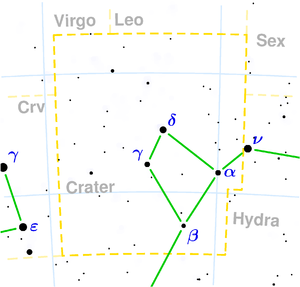
δ Crt - The brightest star in the constellation has an apparent magnitude of 3.82. It is located approximately 163 light-years away from Earth and its luminosity is 171 times greater than that of our Sun.
Alkes (α Crt) - The Arabic name of the main star means "flat dish". Its brightness is only 4.2 magnitude. It is a yellow giant that radiates 66 times more than our Sun. It is located 141 light-years away from us.
γ Crt - The main component has a magnitude of 4.1 and is separated by 5.2" from a companion of magnitude 9.6, which can be observed with a telescope with an objective diameter of about 10 cm. The brighter component is white, while the companion has a blue color. Their light is traveling towards us for 85 years.
NGC 3962
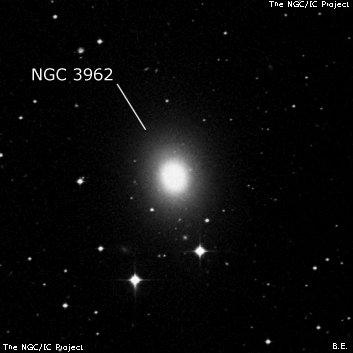
William Herschel discovered NGC 3962 = H I-67 = h3370 on 8 Feb 1785 (sweep 372) and logged "cB, pL, mbM, iF." John Herschel made two observations from the Cape of Good Hope and first logged "vB; R; psmbM; 40"; forms a triangle with 2 stars 10-11m." His position matches MCG -02-30-040 = PGC 37366.
200/250mm - 8" (5/21/82): fairly faint, very small, round, bright core.
400/500mm - 17.5" (5/11/96): bright, moderately large, slightly elongated 5:4 N-S, 2.0'x1.7'. Sharply concentrated with a bright 25" core and increasing to a nonstellar nucleus. Forms a right triangle with two mag 10.5 stars 2.2' S and 3.1' SSE.
Notes by Steve Gottlieb
NGC 3511
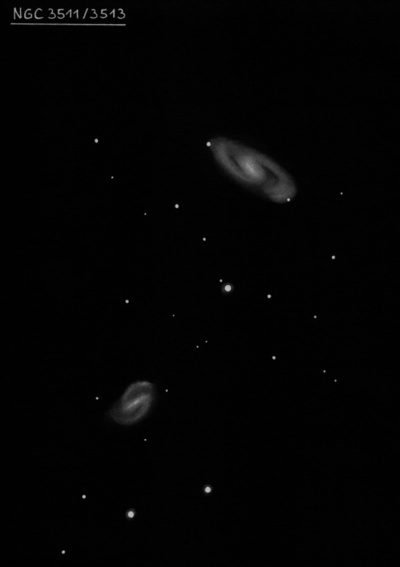
William Herschel discovered NGC 3511 = H V-39, along with NGC 3513, on 21 Dec 1786 (sweep 660), and recorded "vF, mE, vgbM, about 8' long and 3' br, near the parallel but about 10° sp to nf."
400/500mm - 17.5" (4/1/95): fairly bright, large, very elongated 3:1 WSW-ENE, 4.0'x1.4'. Broad concentration to a larger brighter core. The galaxy is bracketed by a mag 13 star at the ENE end and a mag 14 star at the WSW tip. Forms a pair with NGC 3513 10.8' SE. A mag 9.5 star (SAO 179479) is 5' S, roughly midway between the galaxies.
900/1200mm - 48" (4/18/15): at 488x; very bright, very large, elongated 3:1 WSW-ENE, 5'x1.5'. Well concentrated with a large bright oval core that gradually increases to a small bright nucleus and stellar pip. The region surrounding the core is mottled, due to slightly brighter regions and dust patches. An ill defined broad spiral arm is on the west side of galaxy and curved from north to south. A mag 14 star, 2.0' SW of center, was barely off the southwest end of this arm. A bright patch is 1' SW of center (not part of the arm), and just to its north was a relatively large darker (dust) region. A second broad arm arc was visible at the east end of the galaxy. It made a sharp curve clockwise, passing just inside a mag 13 star at the eastern tip. NGC 3513 lies 11' SE.
Notes by Steve Gottlieb
NGC 3981
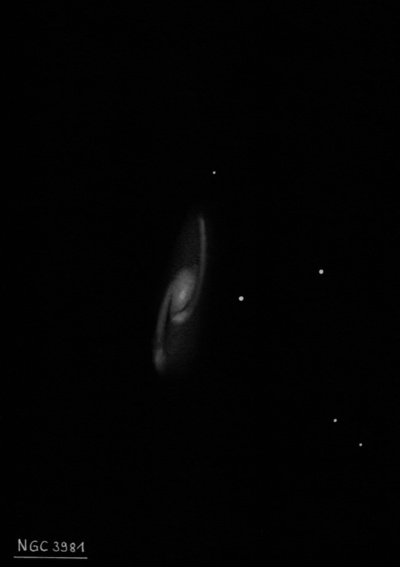
ESO 572-023, located 13' ENE, appeared faint, very small, round, brighter core. I'm surprised this galaxy was missed by Herschel.
William Herschel discovered NGC 3981 = H III-274 on 7 Feb 1785 (sweep 368) and noted "vF, pL, iF." His position is just 1' too far east.
300/350mm - 13.1" (2/16/85): moderately bright, very elongated 3:1 SSW-NNE, weak concentration. A mag 13 star is off the east edge 1.0' from the center. The galaxy forms the east vertex of a rough isosceles triangle with two mag 10 stars 4.2' NW and 5.0' SSW. Member of the NGC 4038/39 (Antennae) group.
900/1200mm - 48" (4/20/17): at 488x; bright, large, very elongated 4:1 SSW-NNE, ~2.5'x0.6'. The central region consists of a bright very elongated bar-like core that condenses to a small brighter nucleus. A fairly thin, straight arm is evident extending north by over 1' on the east side of the galaxy. The counterpart extending south on the west side was more difficult to distinguish from the halo on the south side. A low contrast knot (VV 8b) was visible on the south tip of this arm [1.2' SSW of center]. Vorontsov-Velyaminov interpreted this knot as a companion attached at the end of a spiral arm. A mag 13 star is 1' E and mag 9.8 HD 103615 is 4.3' NW.
Notes by Steve Gottlieb
NGC 3672
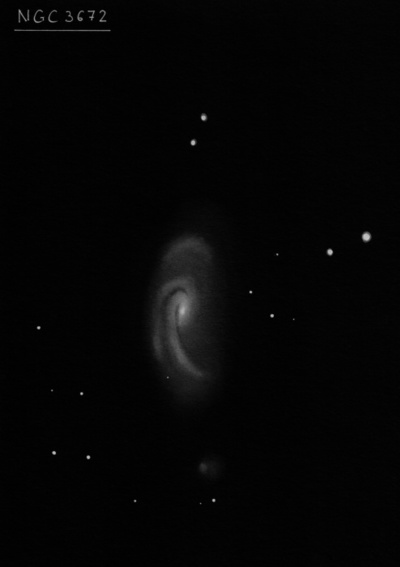
William Herschel discovered NGC 3672 = H I-131 = h886 on 4 Mar 1786 (sweep 597) and reocorded "cB, E, 4 or 5' long and near 4' broad, gbM."
Andrew Ainslie Common probably found this galaxy in 1880 with his 36" reflector, assumed it was new, and reported #17 as "pB, L, bM, E 180°" in his Copernicus discovery list.
200/250mm - 8" (5/21/82): faint, diffuse. Located 20' W of a mag 7.5 star.
400/500mm - 17.5" (3/29/85): fairly bright, fairly large, oval 2:1 N-S, weakly concentrated to the center. Brightest in a small group that includes NGC 3636 and 3637 (LGG 235 = USGC S165).
Notes by Steve Gottlieb
NGC 3722
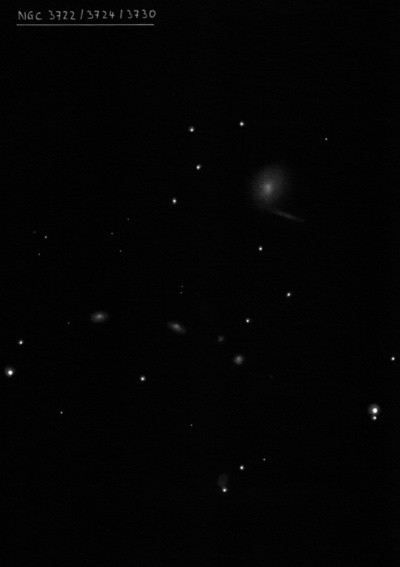
Francis Leavenworth discovered NGC 3722 = LM 2-442, along with NGC 3724, in 1886 and noted "mag 15.0, round, 0.2', sbMN, 1st of 2 [with N3724]." There is nothing at his position, but this number is generally equated with MCG -01-30-005, which lies 1.8 min of RA east (good match in dec). The error in RA is fairly common in the LM discoveries, though there is no galaxy southeast to match NGC 3724 (a companion is northeast).
Corwin proposes PGC 170153 as NGC 3722. This galaxy is a closer match in RA (less than 1 min of RA west) and agrees in declination. Also, NGC 3734 would match IC 2910 in relative offset. See NGC 3734.
400/500mm - 17.5" (4/5/97): extremely faint, very small, round, 15" diameter. First of close trio with MCG -01-30-007 = NGC 3724 (uncertain ID) 1.8' NE and MCG -01-30-008 4.0' NE. Also nearby is MCG -01-30-003 (possibly NGC 3730) 6.4' NNW and a two anonymous galaxies 9' and 10' NNE. Located 10' NNE of NGC 3732. The galaxies in this group have uncertain NGC designations due to poor positions by Leavenworth.
600/800mm - 24" (3/9/13): faint to fairly faint, small, round, 18" diameter, fairly low even surface brightness. Brightest of four in a 4' string, including extremely faint MCG -01-30-006 = PGC 35753 just 0.7' NNE. PGC 35753 appeared extremely faint to very faint, round, just 6" diameter! Member of a large group (USGC S171) at z = .021.
Notes by Steve Gottlieb